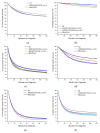Epidemiology of Mucinous Adenocarcinomas
- PMID: 33143115
- PMCID: PMC7692300
- DOI: 10.3390/cancers12113193
Epidemiology of Mucinous Adenocarcinomas
Abstract
Mucinous (colloid) adenocarcinomas (MAs) are a rare histological subtype of adenocarcinomas where extracellular mucin comprises more than 50% of the tumor. Most literature on MAs relate to cancers from colorectal and breast sites; however, the literature lacks a standardized overview of the MA disease entity. Particularly in colorectal cancer, some MAs may have signet ring cells floating within the mucin, which may represent a highly metastatic phenotype. MAs and signet ring cell adenocarcinomas represent a spectrum of mucin-producing neoplastic conditions where in the latter most mucin is intracellular rather than extracellular. We recently published a standardized overview of signet ring cells, and in this companion work, using a retrospective cohort approach, we summarize the clinicodemographic and mortality outcomes of MAs in sixteen primary sites, comprising 95.6% of all MAs in the Surveillance, Epidemiology, and End Results Program (SEER), a population-level cancer database covering nearly one-third of the United States population. Compared to matching nonvariant adenocarcinomas, MAs have a slightly earlier age of onset with increased rates of regional and distant disease at presentation. Survival outcomes are highly dependent on tumor location, illustrating our poor understanding of MA tumor biology. The clinical significance of MA histology depends largely on tumor site.
Keywords: cancer; chemotherapy; colloid carcinoma; histopathology; radiotherapy; surgery.
Conflict of interest statement
The authors declare no conflict of interest.
Figures





References
-
- WHO . Digestive System Tumours. WHO Classification of Tumours Series. 5th ed. International Agency for Research on Cancer; Lyon, France: 2019.
LinkOut - more resources
Full Text Sources

